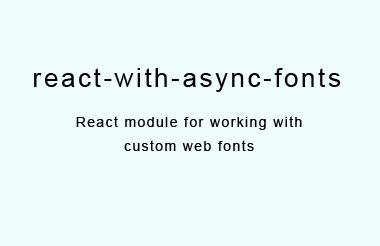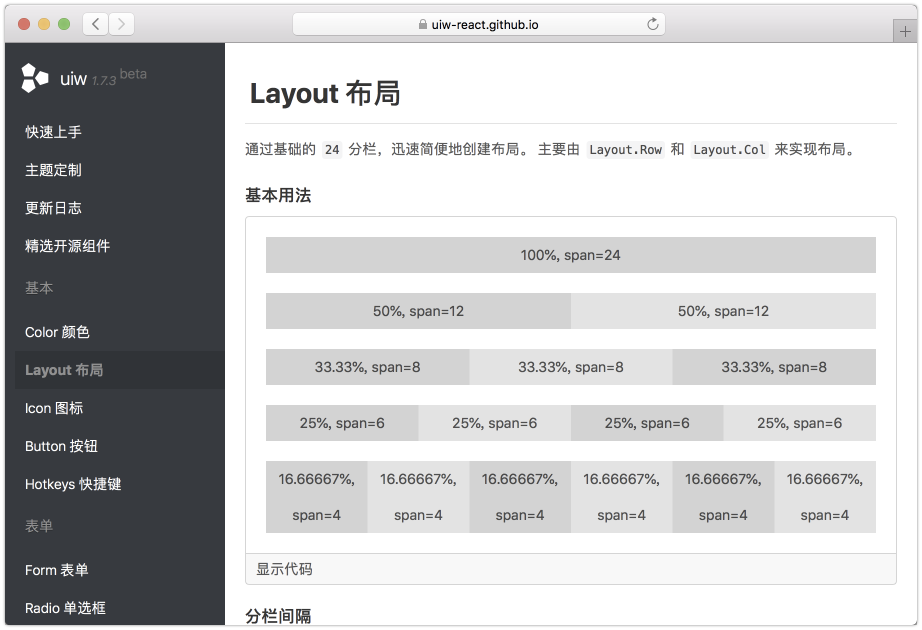react-with-async-fonts
React module for working with async loaded custom web fonts, based on fontfaceobserver.
Note: version 4.x introduces breaking changes with new API. It addresses bunch of issues, including canceling promises, better performance, and TS typings.
Quick Start
- Install
react-with-async-fonts:
npm:
npm install --save react-with-async-fonts
yarn:
yarn add react-with-async-fonts
- Wrap your root component with
FontObserver:
Set prop with font name. You can access it later in FontSubscriber to check if
it's ready.
import { FontObserver } from 'react-with-async-fonts';
import { render } from 'react-dom';
import App from './app';
render(
<FontObserver openSans="Open Sans">
<App />
</FontObserver>,
document.getElementById('root'),
);
- Wrap your target with
FontSubscribercomponent:
Tip: you can also use
withFontsAPI if you're really into
HoCs.
Note that FontSubscriber uses children render prop. Provided function would be
called with single argument which is an object with loaded font keys.
import { FontSubscriber } from 'react-with-async-fonts';
const Heading = ({ children }) => (
<FontSubscriber>
{fonts => (
<h1 className={fonts.openSans ? 'opens-sans-font' : 'system-font'}>
{children}
</h1>
)}
</FontSubscriber>
);
export default Heading;
API
FontObserver component
import { FontObserver } from 'react-with-async-fonts';
| Prop | Type | Description |
|---|---|---|
text |
string |
fontfaceobserver's .load text options |
timeout |
number |
fontfaceobserver's .load timeout options |
[key] |
Font \| string |
Font family string or a Font object. |
FontSubscriber component
import { FontSubscriber } from 'react-with-async-fonts';
| Prop | Type | Description |
|---|---|---|
children |
(fonts: Object) => React.Element<any> |
Children render function. Accepts object with loaded font. Once ready, it would contain object of Font type. |
withFonts HoC
import { withFonts } from 'react-with-async-fonts';
| Argument | Type | Description |
|---|---|---|
| component | React.ComponentType<any> |
Component to wrap with HoC. Injects fonts object. |
Font type
type Font = {
family: String,
weight?:
| 'normal'
| 'bold'
| 'bolder'
| 'lighter'
| '100'
| '200'
| '300'
| '400'
| '500'
| '600'
| '700'
| '800'
| '900',
style?: 'normal' | 'italic' | 'oblique',
stretch?:
| 'normal'
| 'ultra-condensed'
| 'extra-condensed'
| 'condensed'
| 'semi-condensed'
| 'semi-expanded'
| 'expanded'
| 'extra-expanded'
| 'ultra-expanded',
};
Examples
Heads up! Each example requires wrapping your app with
FontObserver:
import React from 'react';
import { render } from 'react-dom';
import { FontObserver } from 'react-with-async-fonts';
import App from './app';
render(
<FontObserver montserrat="Montserrat">
<App />
</FontObserver>,
document.getElementById('root'),
);
Basic with FontSubscriber
import React from 'react';
import { FontSubscriber } from 'react-with-async-fonts';
const Heading = ({ children }) => (
<FontSubscriber>
{fonts => (
<h1 className={fonts.montserrat && 'montserrat-font'}>{children}</h1>
)}
</FontSubscriber>
);
export default Heading;
Basic with withFonts
You can use withFonts HoC if you want to compose your component. Please note
it uses same FontSubscriber under the hood.
import React from 'react';
import { withFonts } from 'react-with-async-fonts';
const Heading = ({ children, fonts }) => (
<h1 className={fonts.montserrat && 'montserrat-font'}>{children}</h1>
);
export default withFonts(Heading);
With styled-components
Most elegant way of using it with styled-components is withFonts HoC.
import styled from 'styled-components';
import { withFonts } from 'react-with-async-fonts';
const Heading = styled.h2`
font-weight: 300;
font-family: ${props =>
props.fonts.montserrat
? '"Open Sans", sans-serif'
: 'Helvetica, sans-serif'};
`;
export default withFonts(Heading);
Nested FontObserver
You can nest FontObserver to merge fonts. Children instances overrides parent
if font with same code was defined.
import { FontObserver, FontSubscriber } from 'react-with-async-fonts';
const Article = ({ title, children }) => (
<FontObserver roboto="Roboto">
<FontObserver ptSans="PT Sans">
<FontSubscriber>
{fonts => (
<article>
<h1 className={fonts.roboto ? 'roboto' : 'sans-serif'}>{title}</h1>
<p className={fonts.ptSans ? 'ptsans' : 'serif'}>{children}</p>
</article>
)}
</FontSubscriber>
</FontObserver>
</FontObserver>
);
export default Article;
Custom fontfaceobserver options
You can provide text and timeout options for
fontfaceobserver's .load
method with same props.
import { FontObserver, FontSubscriber } from 'react-with-async-fonts';
const Heading = ({ children }) => (
<FontObserver text={children} timeout={2500} roboto="Roboto">
<FontSubscriber>
{fonts => <h1 className={fonts.roboto && 'roboto'}>{children}</h1>}
</FontSubscriber>
</FontObserver>
);
export default Heading;





